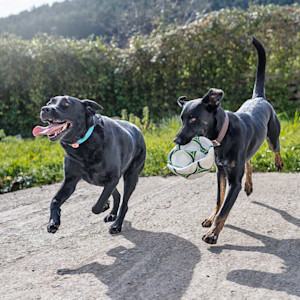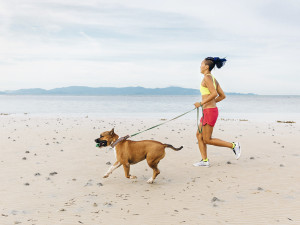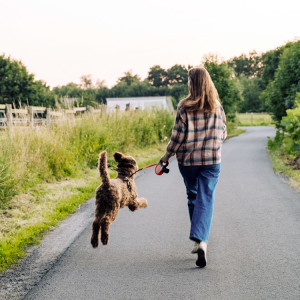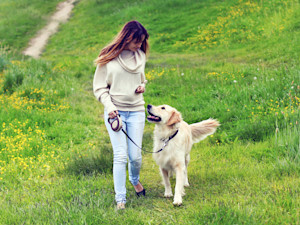Are You Playing Too Much Fetch?
Why fetch might be hurting your dog more than helping

Share Article
Hands up if you and your dog love a bit of fetch. One of the most popular ways to play with our canine companions, fetch can be a lot of fun for dogs and an easy way of providing physical exercise for a lot of pet parents.
But is it possible that we’re overdoing it with the balls and frisbees? Some experts think so. And they’re looking to shed light on the potential consequences too much fetch can have on our dogs’ physical and mental wellbeing.
Yes, you can over-exercise your dog
“Playing fetch with your dog is a great way of providing physical exercise and mental stimulation for them,” says Lauren Bennett, veterinary nurse, and scientific and policy officer at RSPCA. “It promotes the exhibition of normal behaviours like chase and predation, so your dog will experience pleasure from participating.”
But, she says, there’s a catch. “It is possible to over-exercise your dog by playing fetch,” and that can lead to a whole host of medical issues.
As fetch is naturally a fast-paced, repetitive activity that puts a lot of demand on the body, it can mean real risks: think worn joints and muscle strains. Fast, sharp movements – especially over uneven ground – can “accelerate degeneration of joint tissues” or cause injuries such as “grazes of the pads, cuts and nail damage,” says Lauren.
And it’s not just anecdotal. A 2016 studyopens in new tab found that if dogs carry something heavier than they’re bred to carry (which could be the likes of a sturdy football for a larger breed), the added weight placed on their front legs can result in extra stress on joints and muscles.
The veterinary experts over at Canine Arthritis Managementopens in new tab (CAM) also note the “huge impact and torsional forces on joints that are weaker” energetic games like fetch can have. “Repeated micro-trauma to muscles and cartilage is the cause of long-term damage,” they writeopens in new tab.
Some dogs are more vulnerable than others
Some dogs can be more susceptible to the likes of musculoskeletal issues than others. According to Lauren, these include dogs who aren’t skeletally mature so dogs that are “typically below the age of six months for small breeds and 24 months for large breeds.”
Older dogs can be more at risk, too. There’s a sad statisticopens in new tab that 80 percent of dogs aged eight and over (and up to 35 percent of dogs of all ages) have osteoarthritis and this is the most common cause of chronic pain for them. So taking care of our pets’ joints could help to reduce that.
As we’re heading into summer, overdoing fetch can present separate problems. While dehydration and other heat-related illnesses can occur if fetch is played for prolonged periods at any point, the risk of these will increase during warmer weather. “Brachycephalic or flat-faced breeds such as Pugs or French Bulldogs are at particular risk as their ability to cool down by panting and breathing is impaired,” says Lauren.
And it’s important to think about the current state of your dog’s vital organs. As Lauren adds: “Dogs with pre-existing medical conditions – especially those affecting the heart and respiratory systems – are also more likely to suffer because of the high physical demands made by playing fetch.”
Too much of an adrenaline rush
Behaviourally, there can be some issues for our four-legged pals as well, particularly if we (with all the right intentions) aim to tire them out with a game of fetch on walks. “We no longer throw a ball a natural distance for our dog to retrieve at a gentle pace,” says Clinical Animal Behaviourist Jade Nicholasopens in new tab. Using ball launchers “we launch them as far as we can until we see dogs reach physical exhaustion.”
This intensity and repeated adrenaline rush can also result in lots of emotional arousal. You might notice physical indications such as excessive drooling or dilated pupils along with behaviours such as barking, spinning and jumping. And, if that occurs regularly, it could lead to your dog’s behaviour being affected in everyday life.
As Jade explains, “high arousal is linked to poor performanceopens in new tab in tasks, emotional overwhelm, increased intensity of certain behaviours and occasionally the onset of abnormal behavioursopens in new tab.” Plus, dogs can struggle to switch off and relax or sleep, which can make life very difficult for not only them but the people who live with them.
Jade highlights one case she was working with where the dog would excessively bark, pull on the lead and seemed hyperactive at home. After realising that the dog would play fetch on walks until she was exhausted, Jade altered the game and made it shorter. That, along with calming enrichment and plenty of rest, resulted in significant change over the next few weeks. “She now snoozes happily throughout the day, leaves the house calmly and enjoys a mix of activities on her walks that help her to regulate her emotions.”
People experiencing behavioural problems with their dog, typically those linked to aggression, “might be exacerbating the issue by continuing to partake in excessive exercise,” adds Jade. “Modern behaviour research demonstrates high incidenceopens in new tab of pain or discomfort in dogs presenting with behaviour problems and further still finds that many dogs in serious chronic pain will still continueopens in new tab to pursue activities such as fetch and suffer the consequences afterwards.”
How to safely play fetch
No one’s saying you can’t play fetch – but modifying the game can go a long way to helping your dog both physically and behaviourally if you suspect you might have been overdoing it.
The experts recommend the following:
Ditch the ball thrower (unless you are physically impaired and require one) and gently roll the ball along the floor instead.
Make sure you’re playing on flat, stable and softer ground rather than on hills or slippery surfaces.
Keep games short. Throw the ball 3–5 times before taking a 10-minute break. If your dog’s showing signs of becoming exhausted – such as failing to return the ball, plopping down or refusing to move – they’ve done too much.
Try to incorporate some of your dog’s training cues such as sits and waits. Once they can wait for a short amount of time, you can hide the ball and ask them to find it. This is a great way to work their brain and tire them out.
And don’t forget there are plenty more ways to play with and mentally stimulate your dog that don’t involve fetch, particularly if your dog falls into a vulnerable group such as a puppy or senior, or has a known medical condition. Think scent-based games such as finding treats in long grass and simply getting to explore new places. The world’s your oyster.
Resources
“Arthritis in Dogs - The Basicsopens in new tab,” Canine Arthritis Management, 2017
Bockstahler B., et al. “Compensatory Load Redistribution in Labrador retrievers When Carrying Different Weights – A Non-Randomised Prospective Trialopens in new tab,” BMC Veterinary Research, vol. 12, no. 1, June 2016,.
Bray E, et al. “Increasing Arousal Enhances Inhibitory Control In Calm But Not Excitable Dogsopens in new tab,” Animal Cognition, vol. 18, no. 6, July 2015, pp. 1317–29.
“Can Arthritis Be Curedopens in new tab?” Canine Arthritis Management, n.d.
Capon H, et al. “From the Canine Arthritis Management Team: On Throwing Ballsopens in new tab.”, Canine Arthritis Management, n.d.
Mills D., et al. “Behaviour Problems Associated With Pain and Paresthesiaopens in new tab.”, Veterinary Clinics: Small Animal Practice, vol. 54, no. 1, Sept. 2023.
Mills D., et al. “Pain and Problem Behaviour in Cats and Dogsopens in new tab.”, Animals, vol. 10, no. 2, 18 Feb. 2020, p. 318.
Tooley C and Heath S. “Emotional Arousal Impacts Physical Health in Dogs: A Review of Factors Influencing Arousal, With Exemplary Case and Frameworkopens in new tab.”, Animals, vol. 13, no. 3, Jan. 2023, p. 465.
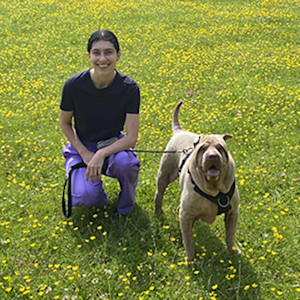
Lauren Sharkey
Lauren Sharkey is a journalist-turned-dog behaviourist who runs Winnie’s Worldopens in new tab: a training and behavioural company that aims to give dogs and their pet parents the life they deserve. She shares her life with a Shar Pei named Winston, who is the inspiration for her career change along with being her biggest love (and challenge!).
Related articles
![dogs running with a football]()
5 Types of Enrichment Every Dog Needs
A well-enriched dog is a happy dog – and who wouldn’t want that?
![Dog chewing spiked orange toy at home]()
6 Ways to Keep Your Dog Entertained While You’re At Work
Don’t hit pause on your pet’s playtime – these solo activities will help 9–5 fly by for them
![woman with new puppy]()
9 Unexpected To-Dos for New Pet Parents
Sound advice from seasoned dog and cat parents who have been there
![A woman wearing colorful activewear running on the beach with her dog.]()
Dogs Make Great Exercise Partners
Helpful tips on staying in shape with your dog
![dog bouncing on lead in the countryside with girl]()
How to Make On-Lead Dog Walks More Exciting
There are plenty of ways to spice them up
![Woman walking a dog on a lead]()
Why Keeping Your Dog On The Lead Isn’t ‘Bad Pet Parenting’
Keeping your dog on a lead isn’t mean – sometimes, it’s the kindest choice

